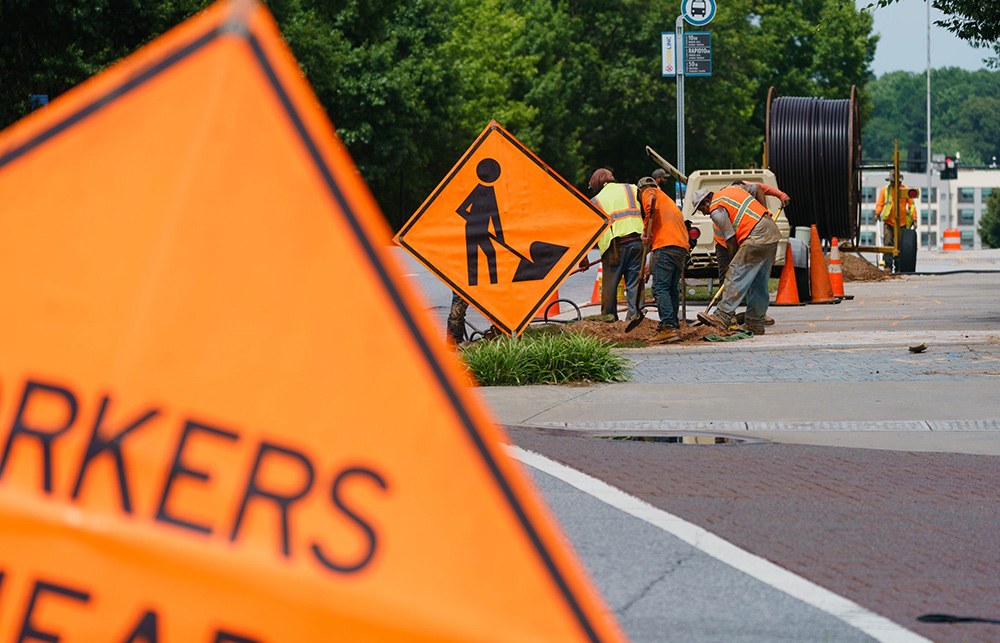
1930年7月7日,,也就是在“大蕭條”(Great Depression)初期,美國(guó)開始正式啟動(dòng)胡佛大壩(Hoover Dam)建設(shè)項(xiàng)目,,這個(gè)大壩耗費(fèi)了500萬桶混凝土,、4500萬磅鋼材和大量人力物力。時(shí)至今日,,還有130萬美國(guó)人的用水,、用電全靠這座90年前修成的大壩。
美國(guó)的歷史就是一部建設(shè)史,,每個(gè)標(biāo)志性的建設(shè)項(xiàng)目,,都體現(xiàn)了敢想敢干的美國(guó)精神。歸于參議院的兩黨合作,,美國(guó)的基建史或?qū)⒑芸扉_啟新的篇章,。一部正在提交眾議院審議的《基建法案》,將為美國(guó)提供了一個(gè)難得機(jī)會(huì),,既能夠在當(dāng)下創(chuàng)造高薪就業(yè),,也可以確保下一個(gè)百年美國(guó)的經(jīng)濟(jì)增長(zhǎng)和領(lǐng)導(dǎo)地位。
作為大型全球化企業(yè)的首席執(zhí)行官,,我們深知,,現(xiàn)代化的基建設(shè)施有助于企業(yè)的運(yùn)營(yíng),也利好企業(yè)的員工,、未來的招聘乃至供應(yīng)鏈,。《基建法案》對(duì)整整一代人來說,,都是一生一次的機(jī)會(huì),,它既能夠保持美國(guó)經(jīng)濟(jì)的全球競(jìng)爭(zhēng)力,讓我們的經(jīng)濟(jì)體系更具包容性,,也可以重建我們的社會(huì)面對(duì)未來危機(jī)所需的韌性,。
在基建問題上,,我們要承擔(dān)兩方面的責(zé)任。當(dāng)然,,美國(guó)應(yīng)該對(duì)未來進(jìn)行大膽的投資,,但是我們也要比前幾代人有更大的勇氣,不能只滿足于維護(hù)現(xiàn)有的基建設(shè)施,?!痘ǚò浮返哪康模瑧?yīng)該是既能夠應(yīng)對(duì)未來的挑戰(zhàn),,同時(shí)也對(duì)現(xiàn)有的基建設(shè)施進(jìn)行改造,,讓子孫后代也可以和我們一樣受益。
要實(shí)現(xiàn)這個(gè)目標(biāo),,首先要解決基建支出嚴(yán)重不足的問題,。在最近的一次評(píng)估中,美國(guó)土木工程師學(xué)會(huì)(American Society of Civil Engineers)對(duì)美國(guó)基礎(chǔ)建設(shè)的評(píng)級(jí)僅為C級(jí),,并指出美國(guó)政府在基建項(xiàng)目上的資金缺口達(dá)到2.59萬億美元,。說美國(guó)的基建差,遠(yuǎn)遠(yuǎn)不止破破爛爛的路橋這么簡(jiǎn)單,。
另外,,我們還應(yīng)該立刻行動(dòng)起來,使美國(guó)的基礎(chǔ)設(shè)施具有足夠的韌性,,讓我們有底氣面對(duì)氣候變化給人的生存帶來的威脅——近幾年美國(guó)肆虐的颶風(fēng)和山火已經(jīng)充分說明了這個(gè)問題的嚴(yán)重性,。聯(lián)邦政府的一項(xiàng)分析發(fā)現(xiàn),2013年,,美國(guó)電網(wǎng)的停電次數(shù)比1984年增加了285%,,停電每年給美國(guó)企業(yè)造成的損失高達(dá)1500億美元。現(xiàn)在,,世界各國(guó)的政府和企業(yè)都在認(rèn)真應(yīng)對(duì)氣候變化問題,,而美國(guó)在這個(gè)問題上有落后的風(fēng)險(xiǎn)。
《基建法案》將使美國(guó)的長(zhǎng)期基礎(chǔ)建設(shè)投資達(dá)到近一個(gè)世紀(jì)以來的最高水平,,相當(dāng)于2009年《復(fù)蘇法案》(Recovery Act)基建投資水平的四倍,。更重要的是,《基建法案》的范疇遠(yuǎn)遠(yuǎn)超出了修路和修橋,。如果眾議院通過了這項(xiàng)法案,,美國(guó)不光是在公路網(wǎng)絡(luò)的維修上,同時(shí)還將在一些對(duì)我們的未來至關(guān)重要的領(lǐng)域上迎來歷史性的投資,。
首先是公共交通和客運(yùn)鐵路系統(tǒng)將迎來有史以來最大規(guī)模投資,,這對(duì)創(chuàng)造就業(yè)和經(jīng)濟(jì)增長(zhǎng)將產(chǎn)生極大影響,同時(shí)也有助于大幅降低交通運(yùn)輸業(yè)(它也是最大的排放源)的排放水平,。與修高速公路相比,,鐵路投資更有助于促進(jìn)公平,,同時(shí)運(yùn)輸效率也顯著強(qiáng)于公路。
其次,,《基建法案》提出了要讓美國(guó)的電網(wǎng)實(shí)現(xiàn)現(xiàn)代化,并且建立一個(gè)全國(guó)性的電動(dòng)汽車充電網(wǎng)絡(luò),。作為一個(gè)擁有完善州際公路網(wǎng)的汽車產(chǎn)業(yè)大國(guó),,這才是美國(guó)必須引領(lǐng)的方向,也是美國(guó)要趕上其他國(guó)家所必須邁出的一步,。
還有一些原因支持我們?cè)诨I(lǐng)域發(fā)力,。研究表明,每向基建領(lǐng)域投資1美元,,就能夠帶來近4美元的經(jīng)濟(jì)增長(zhǎng),。經(jīng)濟(jì)學(xué)家們也同意,基建投資可以創(chuàng)造就業(yè),,提高勞動(dòng)力的經(jīng)濟(jì)參與率,。有研究表明,基建投資能夠創(chuàng)造大量就業(yè)崗位,,而其中85%的崗位并不要求四年制的大學(xué)學(xué)位,。
1935年,當(dāng)726英尺(約221.285米)的胡佛大壩被安上最后一塊磚時(shí),,美國(guó)已經(jīng)有21000名工人參與了它的建設(shè),。胡佛大壩是當(dāng)時(shí)全世界最高的大壩,也是全球第一個(gè)水力發(fā)電和清潔能源項(xiàng)目,。胡佛大壩的故事,,對(duì)今天的美國(guó)仍然有借鑒意義——基建建設(shè)既可以養(yǎng)活全國(guó)各地的工人,也能夠建造出催生明日的變革所需的基建項(xiàng)目,,同時(shí)還可以激活全國(guó)的供應(yīng)鏈,。
21世紀(jì)的第二個(gè)十年始于黑暗和混亂,但只要我們共同努力創(chuàng)造我們想要的未來,,它將在歷史成為轉(zhuǎn)型和大膽行動(dòng)的十年,。何去何從,選擇權(quán)在我們手上,。
我們這次兩黨合作將再次結(jié)出豐碩成果,,讓《基建法案》成為現(xiàn)實(shí)。讓我們現(xiàn)在就行動(dòng)起來,,扭轉(zhuǎn)幾十年來美國(guó)基建投資不足的局面,,為美國(guó)在工程、建設(shè)和創(chuàng)新上的偉大遺產(chǎn)再續(xù)新篇,。(財(cái)富中文網(wǎng))
本文作者芭芭拉·漢普頓是西門子美國(guó)公司(Siemens USA)的總裁兼首席執(zhí)行官,。另一作者馬克·溫伯格曾任安永(EY)的全球主席兼首席執(zhí)行官,。
譯者:樸成奎
1930年7月7日,也就是在“大蕭條”(Great Depression)初期,,美國(guó)開始正式啟動(dòng)胡佛大壩(Hoover Dam)建設(shè)項(xiàng)目,,這個(gè)大壩耗費(fèi)了500萬桶混凝土、4500萬磅鋼材和大量人力物力,。時(shí)至今日,,還有130萬美國(guó)人的用水、用電全靠這座90年前修成的大壩,。
美國(guó)的歷史就是一部建設(shè)史,,每個(gè)標(biāo)志性的建設(shè)項(xiàng)目,都體現(xiàn)了敢想敢干的美國(guó)精神,。歸于參議院的兩黨合作,,美國(guó)的基建史或?qū)⒑芸扉_啟新的篇章。一部正在提交眾議院審議的《基建法案》,,將為美國(guó)提供了一個(gè)難得機(jī)會(huì),,既能夠在當(dāng)下創(chuàng)造高薪就業(yè),也可以確保下一個(gè)百年美國(guó)的經(jīng)濟(jì)增長(zhǎng)和領(lǐng)導(dǎo)地位,。
作為大型全球化企業(yè)的首席執(zhí)行官,,我們深知,現(xiàn)代化的基建設(shè)施有助于企業(yè)的運(yùn)營(yíng),,也利好企業(yè)的員工,、未來的招聘乃至供應(yīng)鏈。《基建法案》對(duì)整整一代人來說,都是一生一次的機(jī)會(huì),,它既能夠保持美國(guó)經(jīng)濟(jì)的全球競(jìng)爭(zhēng)力,讓我們的經(jīng)濟(jì)體系更具包容性,,也可以重建我們的社會(huì)面對(duì)未來危機(jī)所需的韌性。
在基建問題上,,我們要承擔(dān)兩方面的責(zé)任,。當(dāng)然,美國(guó)應(yīng)該對(duì)未來進(jìn)行大膽的投資,,但是我們也要比前幾代人有更大的勇氣,,不能只滿足于維護(hù)現(xiàn)有的基建設(shè)施?!痘ǚò浮返哪康?,應(yīng)該是既能夠應(yīng)對(duì)未來的挑戰(zhàn),同時(shí)也對(duì)現(xiàn)有的基建設(shè)施進(jìn)行改造,讓子孫后代也可以和我們一樣受益,。
要實(shí)現(xiàn)這個(gè)目標(biāo),,首先要解決基建支出嚴(yán)重不足的問題。在最近的一次評(píng)估中,,美國(guó)土木工程師學(xué)會(huì)(American Society of Civil Engineers)對(duì)美國(guó)基礎(chǔ)建設(shè)的評(píng)級(jí)僅為C級(jí),,并指出美國(guó)政府在基建項(xiàng)目上的資金缺口達(dá)到2.59萬億美元。說美國(guó)的基建差,,遠(yuǎn)遠(yuǎn)不止破破爛爛的路橋這么簡(jiǎn)單,。
另外,我們還應(yīng)該立刻行動(dòng)起來,,使美國(guó)的基礎(chǔ)設(shè)施具有足夠的韌性,讓我們有底氣面對(duì)氣候變化給人的生存帶來的威脅——近幾年美國(guó)肆虐的颶風(fēng)和山火已經(jīng)充分說明了這個(gè)問題的嚴(yán)重性,。聯(lián)邦政府的一項(xiàng)分析發(fā)現(xiàn),,2013年,美國(guó)電網(wǎng)的停電次數(shù)比1984年增加了285%,,停電每年給美國(guó)企業(yè)造成的損失高達(dá)1500億美元?,F(xiàn)在,世界各國(guó)的政府和企業(yè)都在認(rèn)真應(yīng)對(duì)氣候變化問題,,而美國(guó)在這個(gè)問題上有落后的風(fēng)險(xiǎn),。
《基建法案》將使美國(guó)的長(zhǎng)期基礎(chǔ)建設(shè)投資達(dá)到近一個(gè)世紀(jì)以來的最高水平,相當(dāng)于2009年《復(fù)蘇法案》(Recovery Act)基建投資水平的四倍,。更重要的是,,《基建法案》的范疇遠(yuǎn)遠(yuǎn)超出了修路和修橋。如果眾議院通過了這項(xiàng)法案,,美國(guó)不光是在公路網(wǎng)絡(luò)的維修上,,同時(shí)還將在一些對(duì)我們的未來至關(guān)重要的領(lǐng)域上迎來歷史性的投資。
首先是公共交通和客運(yùn)鐵路系統(tǒng)將迎來有史以來最大規(guī)模投資,,這對(duì)創(chuàng)造就業(yè)和經(jīng)濟(jì)增長(zhǎng)將產(chǎn)生極大影響,,同時(shí)也有助于大幅降低交通運(yùn)輸業(yè)(它也是最大的排放源)的排放水平。與修高速公路相比,,鐵路投資更有助于促進(jìn)公平,,同時(shí)運(yùn)輸效率也顯著強(qiáng)于公路。
其次,,《基建法案》提出了要讓美國(guó)的電網(wǎng)實(shí)現(xiàn)現(xiàn)代化,,并且建立一個(gè)全國(guó)性的電動(dòng)汽車充電網(wǎng)絡(luò)。作為一個(gè)擁有完善州際公路網(wǎng)的汽車產(chǎn)業(yè)大國(guó),,這才是美國(guó)必須引領(lǐng)的方向,,也是美國(guó)要趕上其他國(guó)家所必須邁出的一步。
還有一些原因支持我們?cè)诨I(lǐng)域發(fā)力,。研究表明,,每向基建領(lǐng)域投資1美元,,就能夠帶來近4美元的經(jīng)濟(jì)增長(zhǎng)。經(jīng)濟(jì)學(xué)家們也同意,,基建投資可以創(chuàng)造就業(yè),,提高勞動(dòng)力的經(jīng)濟(jì)參與率。有研究表明,,基建投資能夠創(chuàng)造大量就業(yè)崗位,,而其中85%的崗位并不要求四年制的大學(xué)學(xué)位。
1935年,,當(dāng)726英尺(約221.285米)的胡佛大壩被安上最后一塊磚時(shí),,美國(guó)已經(jīng)有21000名工人參與了它的建設(shè)。胡佛大壩是當(dāng)時(shí)全世界最高的大壩,,也是全球第一個(gè)水力發(fā)電和清潔能源項(xiàng)目,。胡佛大壩的故事,對(duì)今天的美國(guó)仍然有借鑒意義——基建建設(shè)既可以養(yǎng)活全國(guó)各地的工人,,也能夠建造出催生明日的變革所需的基建項(xiàng)目,,同時(shí)還可以激活全國(guó)的供應(yīng)鏈。
21世紀(jì)的第二個(gè)十年始于黑暗和混亂,,但只要我們共同努力創(chuàng)造我們想要的未來,,它將在歷史成為轉(zhuǎn)型和大膽行動(dòng)的十年。何去何從,,選擇權(quán)在我們手上,。
我們這次兩黨合作將再次結(jié)出豐碩成果,讓《基建法案》成為現(xiàn)實(shí),。讓我們現(xiàn)在就行動(dòng)起來,,扭轉(zhuǎn)幾十年來美國(guó)基建投資不足的局面,為美國(guó)在工程,、建設(shè)和創(chuàng)新上的偉大遺產(chǎn)再續(xù)新篇,。(財(cái)富中文網(wǎng))
本文作者芭芭拉·漢普頓是西門子美國(guó)公司(Siemens USA)的總裁兼首席執(zhí)行官。另一作者馬克·溫伯格曾任安永(EY)的全球主席兼首席執(zhí)行官,。
譯者:樸成奎
On July 7, 1930, at the start of the Great Depression, workers laid down the first of 5 million barrels of concrete and 45 million pounds of steel to build the Hoover Dam. Today, 1.3 million Americans still access water and power thanks to a project completed nearly 90 years ago.
Our history is full of such infrastructure stories, each one woven into America’s can-do spirit. And thanks to bipartisanship in the Senate, it can soon be our turn to write a new chapter. The infrastructure bill now moving ahead in the House provides us with an opportunity to create high-paying jobs today and to build for the next century of American growth and leadership.
As a current and a former CEO of large global businesses, we know how modern infrastructure makes it easier for businesses like ours to strengthen our operations, benefiting employees, future hires, and the supply chain. This is a generational opportunity to make investments in infrastructure that can help keep the U.S. economy competitive globally, make our economic system more inclusive, and rebuild the resiliency our society needs to face future crises.
Our responsibility when it comes to infrastructure is twofold. Yes, we need to boldly invest in our future. But, more than previous generations, we also need to develop the fortitude not to be overwhelmed by the job of just maintaining what we’ve been given. Our charge is to build what is necessary to meet future challenges while also reinventing our inherited physical infrastructure so that future generations benefit from it as much as we have.
These efforts must start by addressing a major gap in infrastructure spending. In its most recent evaluation, the American Society of Civil Engineers gave the United States a C-grade and identified a $2.59 trillion shortfall in government spending on infrastructure projects, the impact extending well beyond crumbling roads and bridges.
We need to act now to make U.S. infrastructure resilient enough to be an asset to us in addressing the existential threat posed by climate change, a threat seen in severe storms and raging wildfires. A federal analysis found that the U.S. electric grid lost power 285% more often in 2013 than it did in 1984, costing American businesses as much as $150 billion per year. Around the world countries and businesses are taking climate change seriously, and we risk falling further behind.
The investment levels established in the bill would deliver the largest long-term investment in U.S. infrastructure in nearly a century, with four times the infrastructure investment unlocked by the 2009 Recovery Act. Critically, the bill’s priorities go well beyond roads and bridges. If the House passes this bill, we’ll not only make historic investments in repairing America’s road network, but in areas that are vital to our future.
Making the largest investments in public transit and in passenger rail in our nation’s history would have an outsize impact on job creation, economic growth, and greening the transportation sector, the biggest source of emissions. Rail investment will improve equity and connect cities more efficiently than highway expansions.
Let’s also not miss out on the opportunity proposed in the framework to modernize our electric grid and start building a nationwide network of electric vehicle chargers. The nation that built the interstate highway system and ushered in the automobile industry must lead the way forward. This is the step we need to catch up to other countries.
There’s still another reason we should roll up our sleeves and get to work, though. Studies show that every dollar invested in infrastructure generates nearly $4 in economic growth. Economists also agree that infrastructure investment will create jobs and increase participation in the labor force. One study looking at the impact of infrastructure investment found that, of the millions of jobs created, 85% of positions will not require a four-year college degree.
In 1935, by the time the final block was put down 726 feet above the canyon floor, more than 21,000 workers had been a part of making the Hoover Dam a reality. They stood up not only the then-tallest dam in the world, but, with its hydroelectric generation, a first-of-its-kind clean power project that reminds us of what’s possible today: workers nationwide building the infrastructure we need for a changing tomorrow, activating a nationwide supply chain.
This decade started in darkness and disruption, but it can ultimately be known for transformation and bold action as we work together to shape the future we want. The choice is ours.
We hope that bipartisanship will again prevail and that an infrastructure bill will become a reality. Let’s act now to reverse decades of underinvestment in America’s infrastructure and add to our remarkable legacy of construction, engineering, and innovation.
Barbara Humpton is president and CEO of Siemens USA. Mark A. Weinberger is former global chairman and CEO of EY.






